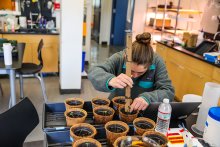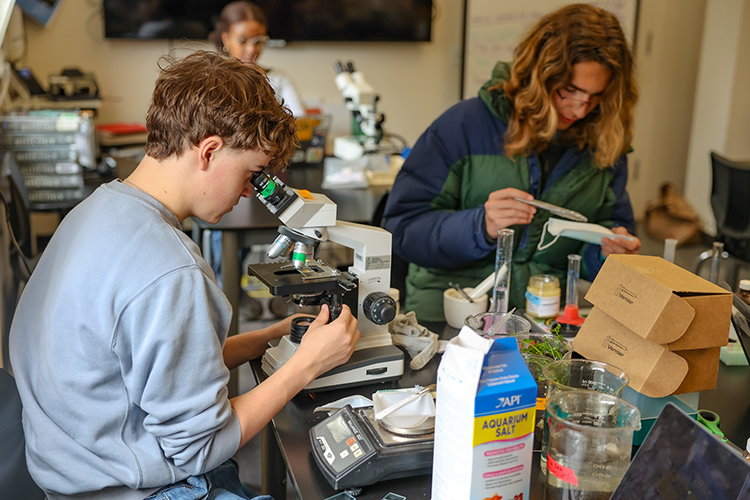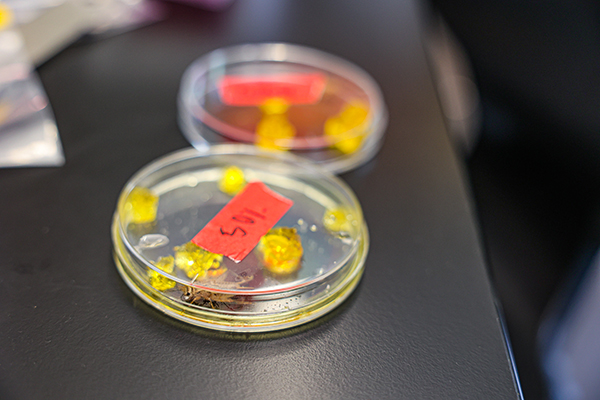
Honors science courses at The Bay School challenge students to design and conduct their own lab-based research studies. Much of the spring semester is spent on these projects, which are presented at the end of the term. Below are a few highlights from the many projects completed in May 2025. The areas for investigation were ecology, human physiology, and modeling complex biology in invertebrates.

ECOLOGY
Students explored the world around them, designed, and performed experiments to test their hypotheses.
Impact of Invasive Eucalyptus on the Growth of Native and Non-Native Plant Species: A student made eucalyptus leaf extract from Presidio eucalyptus leaf litter and compared the growth of California Poppies and invasive radishes exposed to the leaf extract to those exposed to standard water.
The Effects of Red Harvester Ant Group Size on Foraging Behavior in a 3D-Printed Maze: A student designed and 3D printed mazes for populations of ants to navigate. The speed with which they found food was recorded. The summary: many ants make fast work.
A Study of Different San Francisco Water Sites' Water Quality through Coliform: A student collected water from around SF and tested it for coliform (the bacterial species associated with feces). Spoiler alert: don't drink the water from Blue Heron Lake.
Understanding the Effect of Local Policy on Microplastic Amounts in San Franciscan Bass, Samborondón Tilapia, and Hubein Crucian Carp: A student acquired fish from a local fishmonger and dissected their guts to explore microplastic concentration. His interest in environmental policy allowed him to relate his lab findings to the governmental policies in the regions from which the fish came.
HUMAN PHYSIOLOGY
Students explored the plasticity of the human mind through a variety of labs that they designed themselves and then tested on their classmates.
Oxytocin in Action: Measuring Heart Rate and Stress Reduction After Human–Dog Interaction: A student designed a stressful SAT-like test situation and monitored heart rate in teenagers when they took the test alone vs after playing with their cute dog. She found that heart rate during and after the test was much lower after having a brief dog interaction.
The Relationship Between Phone Usage Duration and Short-Term Memory Accuracy: Spoiler alert: more phone use equals worse short term memory!
Comparing Learning Styles: Hands-on vs. Lecture-based Lessons to Teach PCR To 10th Graders: A student taught two different groups of 10th graders a complex molecular biology concept in two ways: lecture or via a hands-on lesson.
The Effects of Learning a New Skill on Reaction Time: A student organized groups of people to either learn a new skill, scroll on Instagram, or meditate for 5 minutes each day before doing three different reaction time tests. He discovered that meditation improves auditory reaction time, while new skills improve visual and kinetic reaction time. Instagram scrolling primarily made reaction time worse.
MODELING COMPLEX BIOLOGY IN INVERTEBRATES
Students used simple model organisms to understand diseases and complex processes in a controlled environment.
The Effect of Different Concentrations of Alcohol on Neural Signaling In Crickets: A student measured the neural output of crickets that had been exposed to increasing concentrations of ethanol. She discovered that alcohol damped the neural signaling of crickets.
Caenorhabditis elegans Under the Influence: Testing the Effects of Caffeine and Ethanol on C. elegans Reproduction: A student grew microscopic nematode worms and exposed them to caffeine or ethanol for various developmental time periods and assessed the effects on egg-laying, fertilization, and development of offspring.
#BaySchoolScience












.jpeg&command_2=resize&height_2=85)





